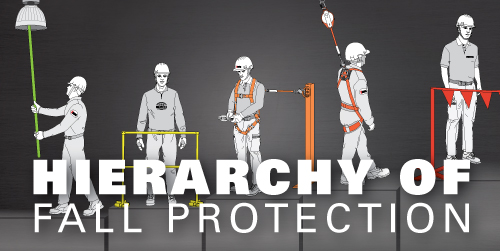Your cart is currently empty!
Hierarchy of Fall Protection

Hierarchy of Fall Protection
The Hierarchy of Fall Protection is the preferred order of control to eliminate or reduce fall hazards. This methodology mirrors common safety practices for hazard abatement beginning with elimination and ending with administrative controls. Using the data collected from the fall hazard assessments, each solution in the hierarchy can be applied to each hazard.
Definition: Hierarchy of fall protection
A ranked or graded series of fall protection solutions ranging from the best solution to the worst. In order of best to worst, these solutions are: Hazard Elimination, Passive Fall Protection, Fall Restraint, Fall Arrest, and Administrative Controls.
1. Hazard Elimination
The preferred solution to all fall hazards is elimination. The reason for exposure to the fall hazard is challenged and evaluated to determine if a change in the procedure, practice, location or equipment will eliminate exposure to the fall hazard. Specifying HVAC (Heating, Venting and Air Conditioning) equipment be located on the ground, or in an equipment room rather than by the edge of the roof, is an example of hazard elimination.
Best Practice
The hierarchy should be applied to any hazard before buying inappropriate equipment or systems. By evaluating a fall hazard using the hierarchy, the best solution is often very evident.
2. Passive Fall Protection
Physical barriers like guardrails around unprotected edges and covers over holes are examples of passive fall protection.
Passive protection is generally considered to provide a higher level of safety since the opportunity for error is less than using personal protective equipment (PPE). The initial costs of passive protection, while possibly high, are often more efficient than the long-term costs of PPE. However, passive protection may not be warranted if the frequency and duration of exposure to the fall hazard is limited.
An exhaustive hazard assessment provides the information needed to make these kinds of decisions to maximize cost-effectiveness.
3. Fall Restraint Systems
Fall restraint systems are erected in such a manner that a fall cannot occur. Fall restraint systems use PPE to restrict the worker’s range of movement so they cannot physically travel to the fall hazard.
Fall restraint systems are often underutilized because they are not specifically mentioned in many regulations, but they are preferred over fall arrest systems. Free fall distance is not an issue for fall restraint systems, therefore arresting forces, clearance requirements, secondary injuries, and rescue issues are virtually eliminated.
Best Practice
Fall restraint is always better than fall arrest. Fall restraint systems prevent most secondary injuries due to the fall and make rescue easy since the worker is still accessible.
4. Fall Arrest Systems
Fall arrest systems are erected in such a manner that a fall can occur but the fall is arrested within acceptable force and clearance margins.
Fall arrest systems have a higher risk associated with them, since we have to stop the falling worker within an acceptable level of force and prevent him/her from contacting the surrounding structure or the ground.
Training for both fall restraint and fall arrest systems is key.
ANSI Z359.2-2007 includes a significant amount of information about fall protection training for authorized persons, competent persons, qualified persons, rescuers and trainers.
5. Administrative Controls
Administrative controls are work practices or procedures that increase a worker’s awareness of a fall hazard. It must be noted that administrative controls are the least preferred method of protection because they do not provide a physical or positive means of protection.
Administrative controls are preventive measures taken to reduce the likelihood of a fall. These methods include safety monitors, warning lines, warning horns, designated areas, or control lines. It must also be noted that OSHA regulates the use of many administrative controls and it is incumbent on the fall protection program administrator to understand the jurisdictions and regulations that apply.
Fall Hazard Survey
The first step for effectively implementing the Hierarchy of Fall Protection is to perform a Fall Hazard Survey to identify and prioritize fall hazards and recommend options for abatement based on regulatory requirements and fall protection standards.